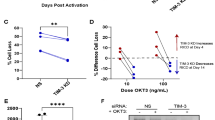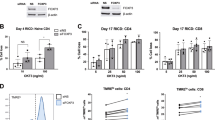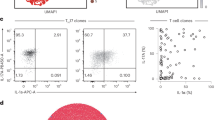Abstract
Human leukocyte antigens (HLA) class II antigen-mediated apoptosis has been documented in antigen-presenting cells and B lymphoproliferations. Characteristics of the apoptosis include rapidity and selectivity for mature cells. Follicular lymphomas are particularly refractory to apoptosis. The B-cell lymphoma Ramos shares characteristics of this subgroup and is insensitive to apoptosis via simple HLA-DR engagement. However, oligomerization of HLA-DR antigens induced caspase activation followed by phosphatidylserine externalization, activation of PKC-δ and cleavage of nuclear lamin B. Mitochondrial injury was also detected. However, inhibition of caspase activation simply delayed the apoptotic phenotype but neither protected against cell death nor prevented mitochondrial injury. The data in this report demonstrate that the requirements for the initiating signal (oligomerization versus engagement) as well as the molecular pathways varies between different B lymphoproliferations despite their common expression of HLA-DR. Finally, blockade of caspase activation in parallel with HLA-DR mAb stimulation could provide a potent autovaccination stimulus by leading to necrotic death of B-cell lymphomas.
This is a preview of subscription content, access via your institution
Access options
Subscribe to this journal
Receive 50 print issues and online access
$259.00 per year
only $5.18 per issue
Buy this article
- Purchase on Springer Link
- Instant access to full article PDF
Prices may be subject to local taxes which are calculated during checkout





Similar content being viewed by others
References
Besnault L, Schrantz N, Auffredou MT, Leca G, Bourgeade MF, Vazquez A . (2001). J Immunol 167: 733–740.
Brick-Ghannam C, Ericson ML, Schelle I, Charron D . (1994). Hum Immunol 41: 216–224.
Brick-Ghannam C, Huang FL, Temime N, Charron D . (1991). J Biol Chem 266: 24169–24175.
Chaouchi N, Vazquez A, Galanaud P, Leprince C . (1995). J Immunol 154: 3096–3104.
Cross T, Griffiths G, Deacon E, Sallis R, Gough M, Watters D et al. (2000). Oncogene 19: 2331–2337.
Drenou B, Blancheteau V, Burgess DH, Fauchet R, Charron DJ, Mooney NA . (1999). J Immunol 163: 4115–4124.
Edinger AL, Thompson CB . (2004). Curr Opin Cell Biol 16: 663–669.
Emoto Y, Manome Y, Meinhardt G, Kisaki H, Kharbanda S, Robertson M et al. (1995). EMBO J 14: 6148–6156.
Funakoshi S, Hirano A, Beckwith M, Asai O, Jorgensen G, Tian Z et al. (1997). Blood 90: 3160–3166.
Ghayur T, Hugunin M, Talanian RV, Ratnofsky S, Quinlan C, Emoto Y et al. (1996). J Exp Med 184: 2399–2404.
Green DR, Scott DW . (1994). Curr Opin Immunol 6: 476–487.
Huby RD, Dearman RJ, Kimber I . (1999). J Biol Chem 274: 22591–22596.
Inman GJ, Allday MJ . (2000a). J Immunol 165: 2500–2510.
Inman GJ, Allday MJ . (2000b). J Immunol 165: 2500–2510.
Lazebnik YA, Cole S, Cooke CA, Nelson WG, Earnshaw WC . (1993). J Cell Biol 123: 7–22.
Leveille C, Zekki H, Al-Daccak R, Mourad W . (1999). Int Immunol 11: 719–730.
Leverkus M, McLellan AD, Heldmann M, Eggert AQ, Brocker EB, Koch N, Kampgen E . (2003). Int Immunol 15: 993–1006.
Majumder PK, Pandey P, Sun X, Cheng K, Datta R, Saxena S et al. (2000). J Biol Chem 275: 21793–21796.
McLellan AD, Terbeck G, Mengling T, Starling GC, Kiener PA, Gold R et al. (2000). Cell Death Differ 7: 933–938.
Mecklenbrauker I, Saijo K, Zheng NY, Leitges M, Tarakhovsky A . (2002). Nature 416: 860–865.
Medema JP, Scaffidi C, Kischkel FC, Shevchenko A, Mann M, Krammer PH et al. (1997). EMBO J 16: 2794–2804.
Miyamoto A, Nakayama K, Imaki H, Hirose S, Jiang Y, Abe M et al. (2002). Nature 416: 865–869.
Mone AP, Huang P, Pelicano H, Cheney CM, Green JM, Tso JY et al. (2004). Blood 103: 1846–1854.
Nagy ZA, Hubner B, Lohning C, Rauchenberger R, Reiffert S, Thomassen-Wolf E et al. (2002). Nat Med 8: 801–807.
Pedersen IM, Buhl AM, Klausen P, Geisler CH, Jurlander J . (2002). Blood 99: 1314–1319.
Rich T, Lawler SE, Lord JM, Blancheteau VM, Charron DJ, Mooney NA . (1997). J Immunol 159: 3792–3798.
Scheel-Toellner D, Pilling D, Akbar AN, Hardie D, Lombardi G, Salmon M et al. (1999). Eur J Immunol 29: 2603–2612.
Setterblad N, Blancheteau V, Delaguillaumie A, Michel F, Becart S, Lombardi G et al. (2004). J Leukoc Biol 75: 1036–1044.
Truman JP, Garban F, Choqueux C, Charron D, Mooney N . (1996). Exp Hematol 24: 1409–1415.
Webb PR, Wang KQ, Scheel-Toellner D, Pongracz J, Salmon M, Lord JM . (2000). Apoptosis 5: 451–458.
Wieder T, Essmann F, Prokop A, Schmelz K, Schulze-Osthoff K, Beyaert R et al. (2001). Blood 97: 1378–1387.
Acknowledgements
This work was supported by grants from the Fondation de France, Association pour la recherche contre le Cancer, European Commission Grants QLK362002-01936 and QLRT200202026
Author information
Authors and Affiliations
Corresponding author
Rights and permissions
About this article
Cite this article
Carmagnat, M., Drénou, B., Chahal, H. et al. Dissociation of caspase-mediated events and programmed cell death induced via HLA-DR in follicular lymphoma. Oncogene 25, 1914–1921 (2006). https://doi.org/10.1038/sj.onc.1209222
Received:
Revised:
Accepted:
Published:
Issue Date:
DOI: https://doi.org/10.1038/sj.onc.1209222



